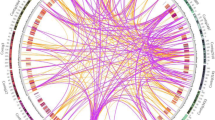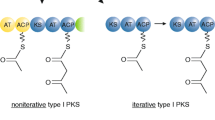Abstract
Phosphomannomutase (PMM; EC 5.4.2.8) is an enzyme that catalyzes the interconversion reaction between mannose-6-phosphate and mannose-1-phosphate. However, its systematic molecular and functional investigations in algae have not hitherto been reported. In this work, with the accomplishment of the 1 000 Plant Project (OneKP) in which more than 218 species of Chromista, including 19 marine phaeophytes, 22 marine rhodophytes, 171 chlorophytes, 5 cryptophytes, 4 haptophytes, and 5 glaucophytes were sequenced, we used a gene analysis method to analyze the PMM gene sequences in algae and confirm the existence of the PMM gene in the transcriptomic sequencing data of Rhodophyta and Ochrophyta. Our results showed that only one type of PMM with four conserved motifs exists in Chromista which is similar to human PMM. Moreover, the phylogenetic tree revealed that algae PMM possibly originated from archaea.
Similar content being viewed by others
References
Catherine R, Grant S S, Lesa J B. 2006. Complexes of the enzyme phosphomannomutase/phosphoglucomutase with a slow substrate and an inhibitor. Protein Structure Communications, 62: 722–726
Christine O, Claus S, Wolfgang G. 1997. The reaction mechanism of phosphomannomutase in plants. FEBS Letters, 401: 35–37
Conklin P L, Norris S R, Wheeler G L, et al. 1999. Genetic evidence for the role of GDP-mannose in plant ascorbic acid (vitamin C) biosynthesis. Proceedings of the National Academy of Sciences of the United States of America, 96: 4198–4203
Conzelmann A, Fankhauser C, Desponds C. 1990. Myoinositol gets incorporated into numerous membrane glycoproteins of Saccharomyces cerevisiae; incorporation is dependent on phosphomannomutase (sec53). The EMBO Journal, 9(3): 653–661
David J S, Michelle C, Mariastella D T, et al. 1992. The Candida albicans PMM1 gene encoding phosphomannomutase complements a Saccharomyces cerevisiae sec 53-6 mutation. Current Genetics, 22(6): 501–503
Gert M, Els S, Els P, et al. 1997a. Mutations in PMM2, a phosphomannomutase gene on chromosome 16p13 in carbohydrate-deficient glycoprotein type I syndrome (Jaeken syndrome). Nature Genetics, 16: 88–92
Gert M, Els S, Michel P, et al. 1997b. PMM (PMM1), the Human Homologue of SEC53 or Yeast Phosphomannomutase, Is Localized on Chromosome 22q13. Genomics, 40(1): 41–47
Gurvan M, Thierry T, Delphine S, et al. 2010. The cell wall polysaccharide metabolism of the brown alga Ectocarpus siliculosus. Insights into the evolution of extracellular matrix polysaccharides in Eukaryotes. New Phytologist, 188: 82–97
Hancock R D, McRae D, Haupt A, et al. 2003. Synthesis of L-ascorbic acid in the phloem. BMC Plant Biology, 24: 3–7
Hoeberichts F A, Vaeck E, Kiddle G, et al. 2008. A temperature-sensitive mutation in the Arabidopsis thaliana phosphomannomutase gene disrupts protein glycosylation and triggers cell death. Journal of Molecular Biology, 283: 5708–5718
Hudson H F, Markus A. 1999. Molecular basis of carbohydrate-deficient glycoprotein syndromes type I with normal phosphomannomutase activity. Biochimica et Biophysica Acta (BBA) - Molecular Basis of Disease, 1455: 167–178
Hudson H F. 2006. Genetic defects in the human glycome. Nature Reviews Genetics, 7: 537–551
Huelsenbeck J P, Ronquist F R. 2001. MrBayes: Bayesian inference of phylogeny. Bioformatics, 17: 754–755
Jaeken J, Artigas J, Barone R, et al. 1997. Phosphomannomutase deficiency is the main cause of carbohydrate-deficient glycoprotein syndrome with type I isoelectrofocusing pattern of serum sialotransferrins. Journal of Inherited Metabolic Disease, 20: 447–449
Jean-Francois C, Vincent S, Michel P, et al. 1998. A New Class of Phosphotransferases Phosphorylated on an Aspartate Residue in an Amino-terminal DXDX(T/V) Motif. The Journal of Biological Chemistry, 273: 14107–14112
Kepes F, Schekman R. 1998. The yeast SEC53 gene encodes phosphomannomutase. The Journal of Biological Chemistry, 263: 9155–9161
Laura E N, Peter A T. 2001. Kinetic Mechanism and pH Dependence of the Kinetic Parameters of Pseudomonas aeruginosa Phosphomannomutase/Phosphoglucomutase. Archives of Biochemistry and Biophysics, 396: 111–118
Leen H, Ela S, Stephanie G, et al. 2001. Identification and localization of two mouse phosphomannomutase genes, Pmm1 and Pmm2. Gene, 270: 53–59
Li Ruiqiang, Li Yingrui, Karsten K, et al. 2008. SOAP: short oligonucleotide alignment program. Bioinformatics, 24(5): 713–714
Lukasz K, Robyn M, Brian J S, et al. 2006. Structure of Leishmania Mexicana Phosphomannomutase Highlights Similarities with Human Isoforms. Journal of Molecular Biology, 363: 215–227
Nicholas R S, Chunchun Z, Zhibing L, et al. 2006. The X-ray Crystal Structures of Human α-Phosphomannomutase 1 Reveal the Structural Basis of Congenital Disorder of Glycosylation Type 1a. The Journal of Bilogical Chemistry, 281: 14918–14926
Page R D. 1996. TREEVIEW: An application to display phylogenetic trees on personal computers. Computer Applications in the Biosciences, 12: 357–358
Patricia L C, Susan R N, Glen L W, et al. 1998. Genetic evidence for the role of GDP-mannose in plant ascorbic acid (vitamin C) biosynthesis. Proceedings of the Nationla Academy of Sciences of the United States of America, 96: 4198–4203
Qian Weiqiang, Yu Chunmei, Qin Huanju, et al. 2007. Molecular and functional analysis of phosphomannomutase (PMM) from higher plants and genetic evidence for the involvement of PMM in ascorbic acid biosynthesis in Arabidopsis and Nicotiana benthamiana. The Plant Journal, 49(3): 399–413
Oesterhelt C, Schnarrenberger C, Gross W. 1996. Phosphomannomutase and phosphoglucomutase in the red alga Galdieria sulphuraria. Plant Science, 121: 19–27
Oesterhelt C, Schnarrenberger C, Gross W. 1997. The reaction mechanism of phosphomannomutase in plants. FEBS Letter, 401: 35–37
Rita Q, Ana M, Luisa A, et al. 2010. Evolutionary History and Functional Diversification of Phosphomannomutase Genes. Journal of Molecular Evolution, 71(2): 119–127
Ronquist F, Huelsenbeck J P. 2003. Mrbayes 3: Bayesian phylogenetic inference under mixed models. Bioinformatics, 19: 1572–1574
Smirnoff N, Conklin P L, Loewus F A. 2001. Biosynthesis of ascorbic acid in plants: a renaissance. Plant Physiology and Plant Molecular Biology, 52: 437–467
Sun-Hoi K, Sun-Hee A, Jong-Hee L, et al. 2003. Genetic analysis of phosphomannomutase/phosphoglucomutase from Vibrio furnissii and characterization of its role in virulence. Arch Microbiol, 180: 240–250
Thompson J D, Gibson T J, Plewniak F, et al. 1997. The ClustalX windows interface: flexible strategies for multiple sequence alignment aided by quality analysis tools. Nucleic Acids Res, 25: 4876–4882
Wheeler G L, Jones M A, Smirnoff N. 1998. The biosynthetic pathway of vitamin C in higher plants. Nature, 393: 365–369
Author information
Authors and Affiliations
Corresponding authors
Additional information
Foundation item: The National High Technology Research and Development Program of China under contract No.2012AA10A406; the National Natural Science Foundation of China under contract Nos 41206116, 31140070 and 31271397; Technology Project of Ocean and Fisheries of Guangdong Province under contract No. A201201E03; the Fundamental Research Funds for the Central Universities under contract No. 201262003; China Postdoctoral Science Foundation under contract No. 2011M501167; the algal transcriptome sequencing was supported by 1KP Project (www.onekp.com).
Rights and permissions
About this article
Cite this article
Feng, Y., Chi, S., Liu, C. et al. The discovery of archaea origin phosphomannomutase in algae based on the algal transcriptome. Acta Oceanol. Sin. 33, 108–113 (2014). https://doi.org/10.1007/s13131-014-0447-0
Received:
Accepted:
Published:
Issue Date:
DOI: https://doi.org/10.1007/s13131-014-0447-0




